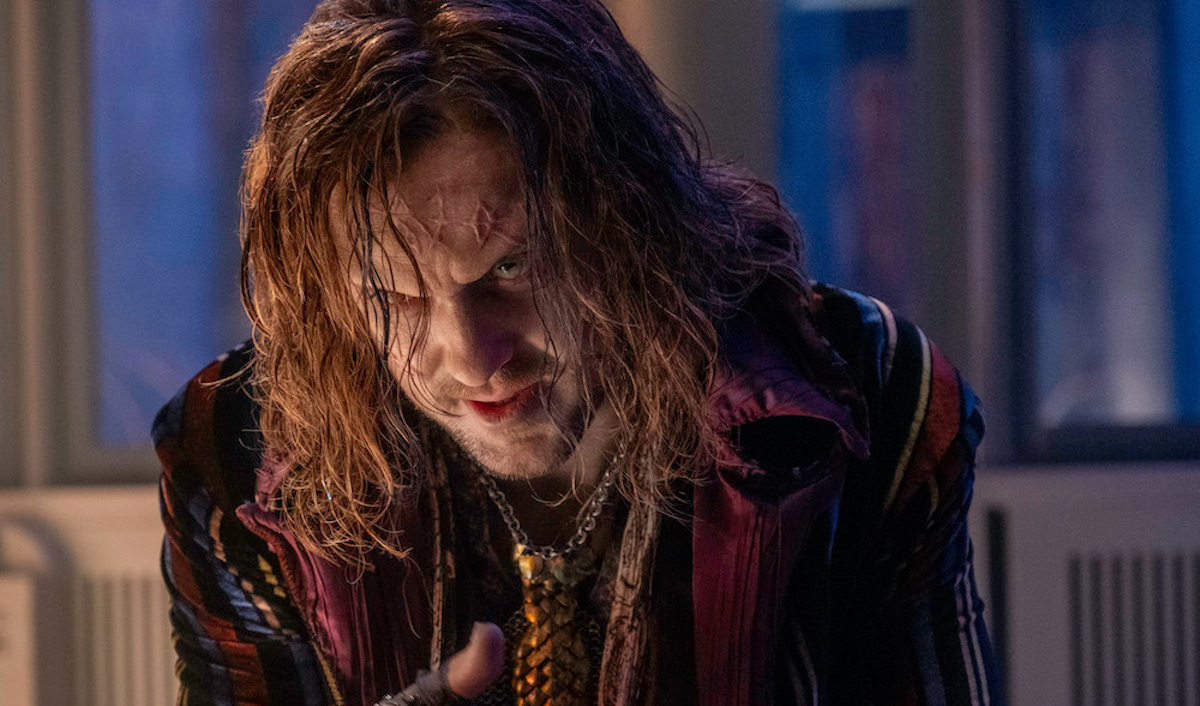In the U.K., the pop culture phrase “behind the sofa” is used to refer to media that is scary enough to prompt kids to hide behind the nearest piece of furniture, but engaging enough to keep them from out-right fleeing the room. Strongly associated with Doctor Who, “behind the sofa” is a concept that can be applied far beyond the long-running science fiction series to speculative fiction (in particular horror) media targeted toward children and families. It’s perhaps a phrase British-American director Rachel Talalay, known for her work on some of NuWho’s most visually-ambitious installments, had in mind when directed Netflix’s recently-released kids horror-fantasy flick A Babysitter’s Guide to Monster Hunting.
A Babysitter’s Guide to Monster Hunting, adapted for the screen by Joe Ballarini from his middle grade book series, has its share of scares—especially in the film’s first few minutes. The movie opens on a little girl, Kelly, trying to fall asleep in her darkened room. Shadows dance and floorboards creak; it’s a familiar scene for anyone who has ever been a little kid afraid of the darkness. But Kelly’s fears are valid. As the scene progresses, long, slender fingers reach around the closet door and a monster enters the scene. It’s the Grand Guignol (Tom Felton), better known as the Boogeyman, and he’s here to steal Kelly’s nightmares.
“That’s the scariest thing in the movie,” says Talalay when I talk to her about the introduction as part of a longer conversation breaking down the five scariest scenes she’s directed across her long, often creepy career. “And it was the most difficult and controversial scene we did from the standpoint of: How scary can you be? You’re opening up the movie, and what is the tone of this movie and where are we going?”
The film’s opening quickly transitions to Kelly (Tamara Smart), now a teenager, waking up in math class. She has escaped her dream of the Grand Guignol, but the Boogeyman is about to come back into her life. When Kelly is forced to babysit on Halloween night, she thinks the worst thing that will happen to her is having to miss the party her crush will be attending… until the Grand Guignol sneaks into the house and steals charge Jacob (Ian Ho) away. In her frantic quest to find him, she meets Liz (Oona Laurence), a member of a society of babysitters who work to keep kids safe from the many monsters that go bump in the night.
The film never gets terrifying, but the closest it comes is with the depiction of the Grand Guignol. In the source material, the Grand Guignol is a grotesque creature with goat legs and cockroaches crawling in his hair. The character is reimagined, visually, for the film.
“It’s completely subjective how scary you make it,” says Talalay of the character. “It’s makeup. And then how can you make his makeup original? There isn’t. One thing I learned is that if you go too far off the beaten track, it just confuses people. You have to have certain elements that feel like you expect it to feel.”
In the film, Felton’s Boogeyman is part rock star, part monster. At one point, when he is trying to lull Jacob to sleep so that he can use his nightmares to create horrific creatures, he sings a lullaby t hypnotize him—an addition to the character that wasn’t present in the book.
“Tom is very musical and so he just embraced that part of this character,” says Talalay, noting that Felton worked to create an antagonist who was just the right amount of scary, asking questions like: “Would you want a little bit of campiness? A little bit of delight? A little bit of legit scary?” Talalay adds: “It’s really, really hard to find that balance. And we’ll never find a balance that everybody’s happy with.”
As a kid, some of the scariest movie moments come when you’re not convinced the protagonist can take care of themself. While Kelly may have her stumbles, she’s brave and capable and, perhaps most interestingly, she has a mind for math—another addition to the story that came straight from Talalay—that helps keep her safe when other avenues fail her.
“Girl power and STEM power were really important to me,” says Talalay, who studied math at Yale and worked as a computer programmer before deciding to become a director. “And so that whole idea that she can see her own version of Sherlock calculations, and that she takes shit for it. But ultimately, that part of her personality is what is her strength. That was definitely autobiographical, in a way.”
While Kelly is the film’s protagonist, jaded babysitter/monster-hunter Liz is a supporting character with a strong arc.
“One thing I responded to in the script was that Liz had prickles,” says Talalay of the character. “Everybody didn’t have to be perfect. That she had prickles and then you learn why. So I liked that about it. It wasn’t afraid to allow her to be somewhat less likable to start with. And then you understand why and then let her grow into it. She has an arc as well.”
Past the chance to direct another feature film—the first for Talalay, who hasn’t gotten the opportunities she deserves in Hollywood, since 1995’s Tank Girl—A Babysitter’s Guide to Monster Hunting gave Talalay to test her family-friendly horror prowess while also telling a story that centers teen girls.
“It’s always important to me that the girls be their own people, and that they have their own strengths,” says Talalay. There’s a little bit of Tank Girl in all of us. So that’s what I say now, is you may not identify it specifically, but there’s a bit of that is always going to be fighting, and fighting the patriarchy, and fighting everything that we’re fighting. Fighting our demons.”
A Babysitter’s Guide to Monster Hunting is now available to stream on Netflix.
